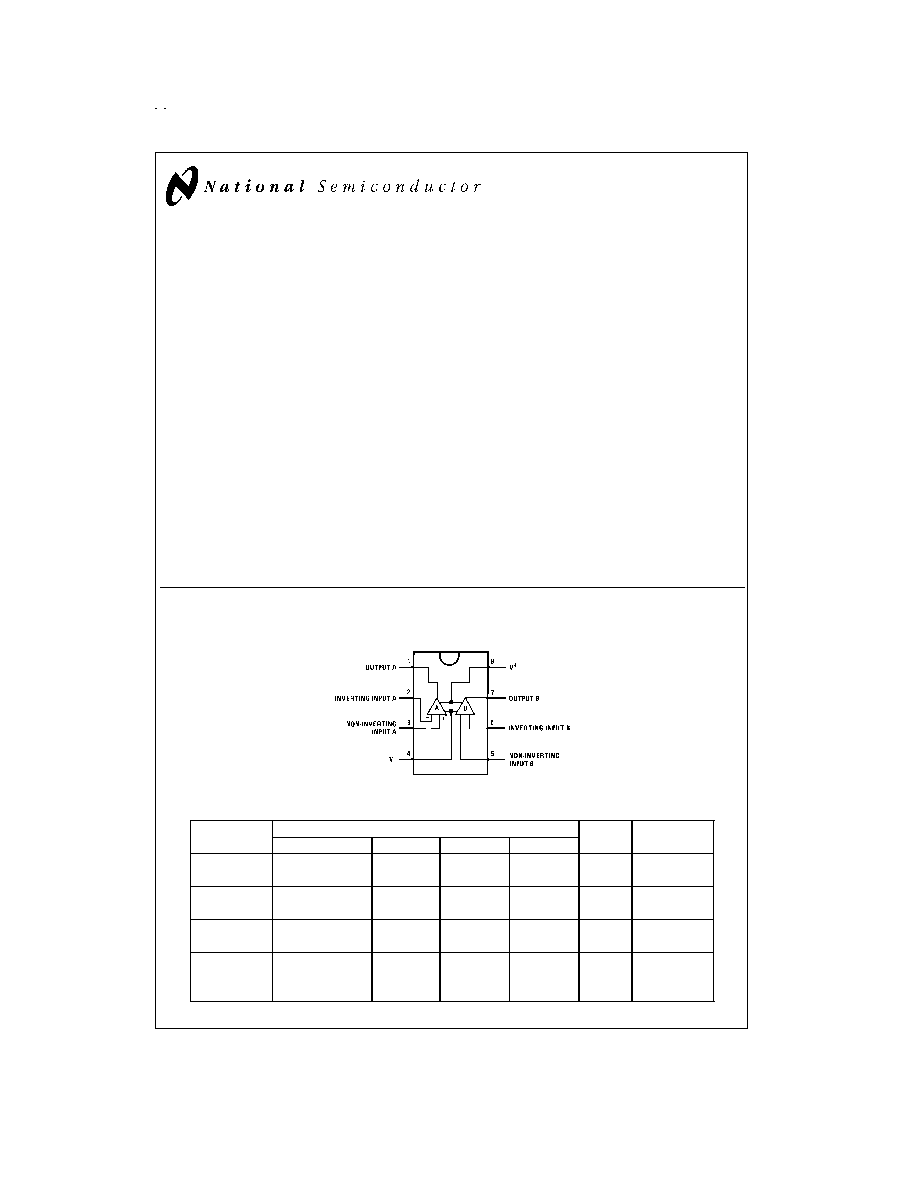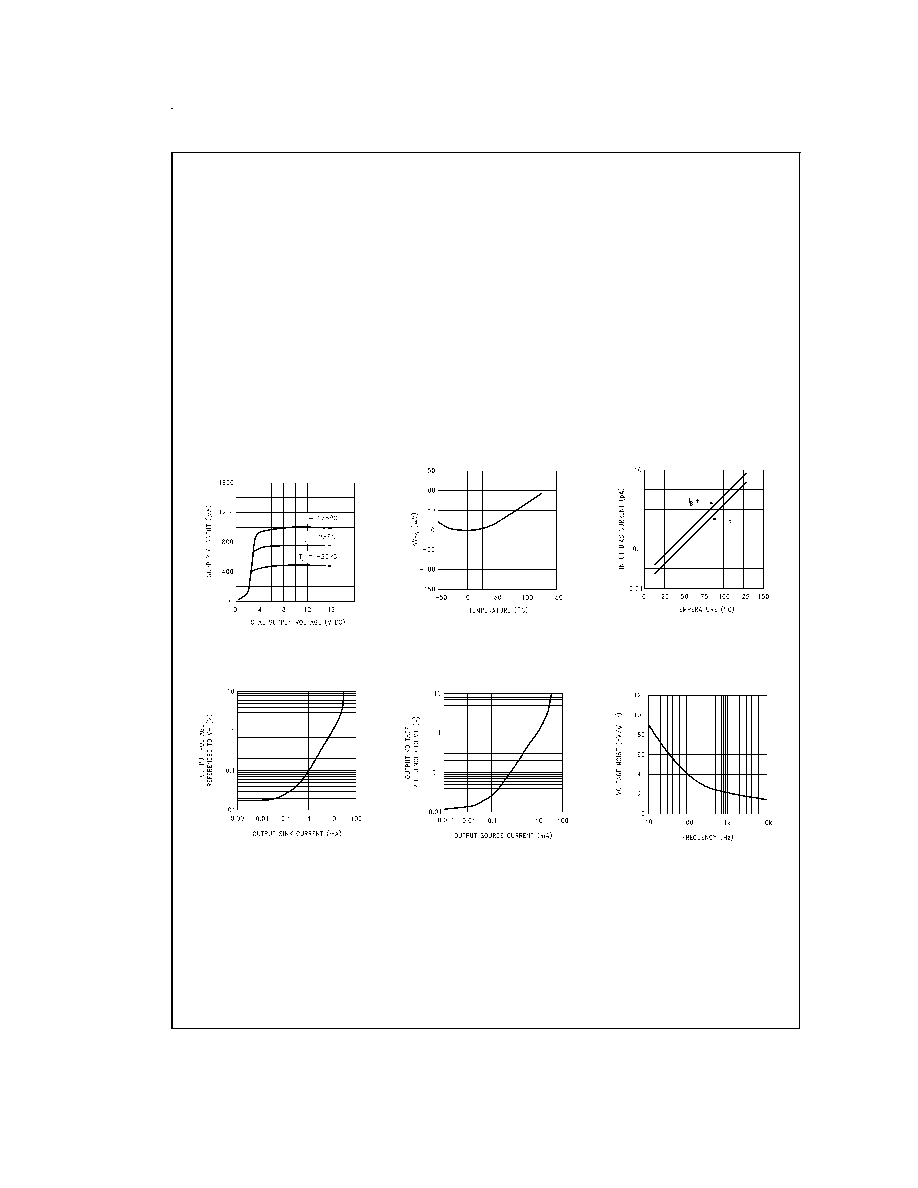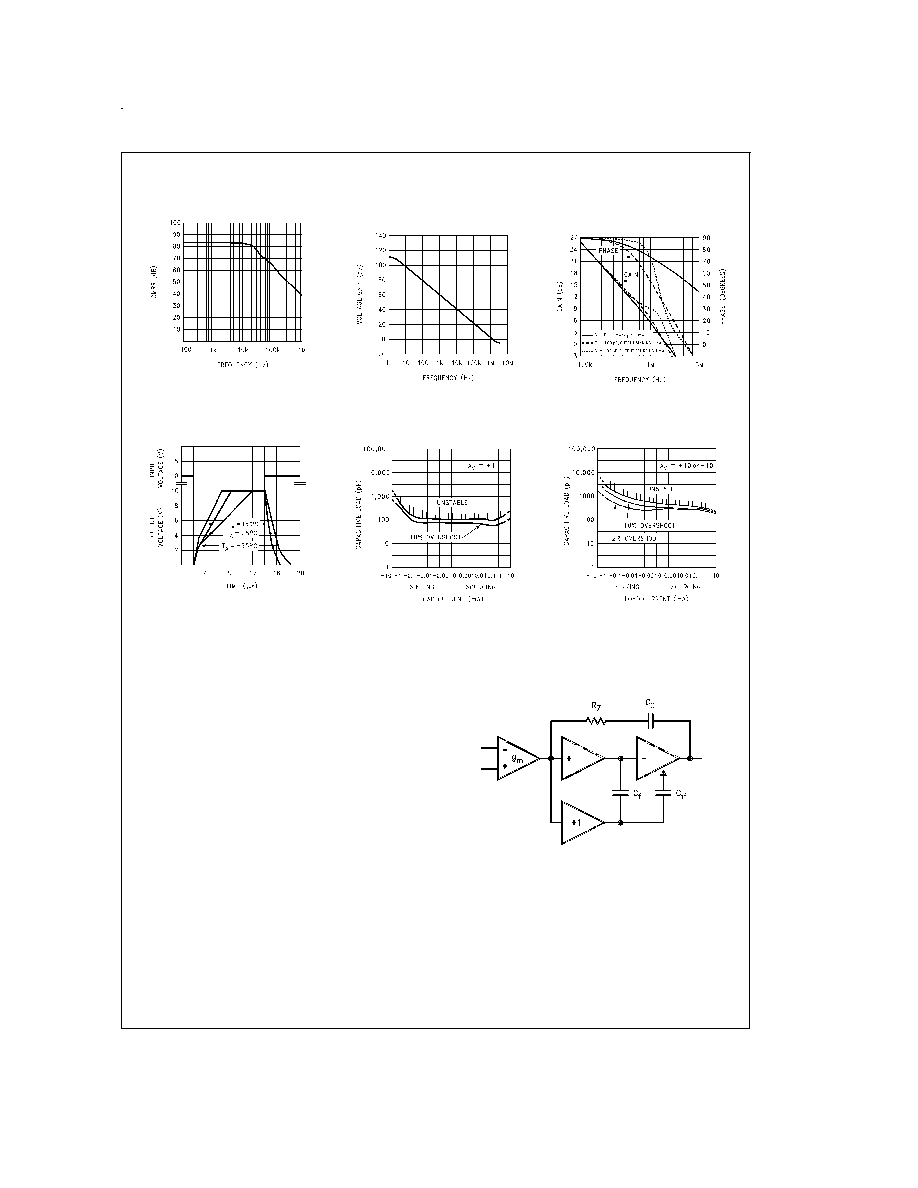
LMC662
CMOS Dual Operational Amplifier
General Description
The LMC662 CMOS Dual operational amplifier is ideal for
operation from a single supply. It operates from +5V to +15V
and features rail-to-rail output swing in addition to an input
common-mode range that includes ground. Performance
limitations that have plagued CMOS amplifiers in the past
are not a problem with this design. Input V
OS
, drift, and
broadband noise as well as voltage gain into realistic loads
(2 k
and 600
) are all equal to or better than widely ac-
cepted bipolar equivalents.
This chip is built with National's advanced Double-Poly
Silicon-Gate CMOS process.
See the LMC660 datasheet for a Quad CMOS operational
amplifier with these same features.
Features
n
Rail-to-rail output swing
n
Specified for 2 k
and 600
loads
n
High voltage gain:
126 dB
n
Low input offset voltage:
3 mV
n
Low offset voltage drift:
1.3 �V/�C
n
Ultra low input bias current:
2 fA
n
Input common-mode range includes V
-
n
Operating range from +5V to +15V supply
n
I
SS
= 400 �A/amplifier; independent of V+
n
Low distortion:
0.01% at 10 kHz
n
Slew rate:
1.1 V/�s
n
Available in extended temperature range (-40�C to
+125�C); ideal for automotive applications
n
Available to a Standard Military Drawing specification
Applications
n
High-impedance buffer or preamplifier
n
Precision current-to-voltage converter
n
Long-term integrator
n
Sample-and-hold circuit
n
Peak detector
n
Medical instrumentation
n
Industrial controls
n
Automotive sensors
Connection Diagram
Ordering Information
Package
Temperature Range
NSC
Drawing
Transport
Media
Military
Extended
Industrial
Commercial
8-Pin
LMC662AMJ/883
J08A
Rail
Ceramic DIP
8-Pin
LMC662EM
LMC662AIM
LMC662CM
M08A
Rail,
Small Outline
Tape and Reel
8-Pin
LMC662EN
LMC662AIN
LMC662CN
N08E
Rail
Molded DIP
8-Pin
Side Brazed
LMC662AMD
D08C
Rail
Ceramic DIP
8-Pin DIP/SO
DS009763-1
April 1998
LMC662
CMOS
Dual
Operational
Amplifier
� 1999 National Semiconductor Corporation
DS009763
www.national.com

Absolute Maximum Ratings
(Note 3)
If Military/Aerospace specified devices are required,
please contact the National Semiconductor Sales Office/
Distributors for availability and specifications.
Differential Input Voltage
�
Supply Voltage
Supply Voltage (V
+
- V
-
)
16V
Output Short Circuit to V
+
(Note 12)
Output Short Circuit to V
-
(Note 1)
Lead Temperature
(Soldering, 10 sec.)
260�C
Storage Temp. Range
-65�C to +150�C
Voltage at Input/Output Pins
(V
+
) +0.3V, (V
-
) -0.3V
Current at Output Pin
�
18 mA
Current at Input Pin
�
5 mA
Current at Power Supply Pin
35 mA
Power Dissipation
(Note 2)
Junction Temperature
150�C
ESD Tolerance (Note 8)
1000V
Operating Ratings
(Note 3)
Temperature Range
LMC662AMJ/883,
LMC662AMD
-55�C
T
J
+125�C
LMC662AI
-40�C
T
J
+85�C
LMC662C
0�C
T
J
+70�C
LMC662E
-40�C
T
J
+125�C
Supply Voltage Range
4.75V to 15.5V
Power Dissipation
(Note 10)
Thermal Resistance (
JA
) (Note 11)
8-Pin Ceramic DIP
100�C/W
8-Pin Molded DIP
101�C/W
8-Pin SO
165�C/W
8-Pin Side Brazed Ceramic DIP
100�C/W
DC Electrical Characteristics
Unless otherwise specified, all limits guaranteed for T
J
= 25�C. Boldface limits apply at the temperature extremes. V
+
= 5V,
V
-
= 0V, V
CM
= 1.5V, V
O
= 2.5V and R
L
>
1M unless otherwise specified.
Parameter
Conditions
Typ
(Note 4)
LMC662AMJ/883
LMC662AI
LMC662C
LMC662E
Units
LMC662AMD
Limit
Limit
Limit
Limit
(Notes 4, 9)
(Note 4)
(Note 4)
(Note 4)
Input Offset Voltage
1
3
3
6
6
mV
3.5
3.3
6.3
6.5
max
Input Offset Voltage
1.3
�V/�C
Average Drift
Input Bias Current
0.002
20
pA
100
4
2
60
max
Input Offset Current
0.001
20
pA
100
2
1
60
max
Input Resistance
>
1
Tera
Common Mode
0V
V
CM
12.0V
83
70
70
63
63
dB
Rejection Ratio
V
+
= 15V
68
68
62
60
min
Positive Power Supply
5V
V
+
15V
83
70
70
63
63
dB
Rejection Ratio
V
O
= 2.5V
68
68
62
60
min
Negative Power Supply
0V
V
-
-10V
94
84
84
74
74
dB
Rejection Ratio
82
83
73
70
min
Input Common-Mode
V
+
= 5V & 15V
-0.4
-0.1
-0.1
-0.1
-0.1
V
Voltage Range
For CMRR
50 dB
0
0
0
0
max
V
+
- 1.9
V
+
- 2.3
V
+
- 2.3
V
+
- 2.3
V
+
- 2.3
V
V
+
- 2.6
V
+
- 2.5
V
+
- 2.4
V
+
- 2.6
min
Large Signal
R
L
= 2 k
(Note 5)
2000
400
440
300
200
V/mV
Voltage Gain
Sourcing
300
400
200
100
min
Sinking
500
180
180
90
90
V/mV
70
120
80
40
min
R
L
= 600
(Note 5)
1000
200
220
150
100
V/mV
Sourcing
150
200
100
75
min
Sinking
250
100
100
50
50
V/mV
35
60
40
20
min
www.national.com
2

DC Electrical Characteristics
(Continued)
Unless otherwise specified, all limits guaranteed for T
J
= 25�C. Boldface limits apply at the temperature extremes. V
+
= 5V,
V
-
= 0V, V
CM
= 1.5V, V
O
= 2.5V and R
L
>
1M unless otherwise specified.
Parameter
Conditions
Typ
(Note 4)
LMC662AMJ/883
LMC662AI
LMC662C
LMC662E
Units
LMC662AMD
Limit
Limit
Limit
Limit
(Notes 4, 9)
(Note 4)
(Note 4)
(Note 4)
Output Swing
V
+
= 5V
4.87
4.82
4.82
4.78
4.78
V
R
L
= 2 k
to V
+
/2
4.77
4.79
4.76
4.70
min
0.10
0.15
0.15
0.19
0.19
V
0.19
0.17
0.21
0.25
max
V
+
= 5V
4.61
4.41
4.41
4.27
4.27
V
R
L
= 600
to V
+
/2
4.24
4.31
4.21
4.10
min
0.30
0.50
0.50
0.63
0.63
V
0.63
0.56
0.69
0.75
max
V
+
= 15V
14.63
14.50
14.50
14.37
14.37
V
R
L
= 2 k
to V
+
/2
14.40
14.44
14.32
14.25
min
0.26
0.35
0.35
0.44
0.44
V
0.43
0.40
0.48
0.55
max
V
+
= 15V
13.90
13.35
13.35
12.92
12.92
V
R
L
= 600
to V
+
/2
13.02
13.15
12.76
12.60
min
0.79
1.16
1.16
1.45
1.45
V
1.42
1.32
1.58
1.75
max
Output Current
Sourcing, V
O
= 0V
22
16
16
13
13
mA
V
+
= 5V
12
14
11
9
min
Sinking, V
O
= 5V
21
16
16
13
13
mA
12
14
11
9
min
Output Current
Sourcing, V
O
= 0V
40
19
28
23
23
mA
V
+
= 15V
19
25
21
15
min
Sinking, V
O
= 13V
39
19
28
23
23
mA
(Note 12)
19
24
20
15
min
Supply Current
Both Amplifiers
0.75
1.3
1.3
1.6
1.6
mA
V
O
= 1.5V
1.8
1.5
1.8
1.9
max
AC Electrical Characteristics
Unless otherwise specified, all limits guaranteed for T
J
= 25�C. Boldface limits apply at the temperature extremes. V
+
= 5V,
V
-
= 0V, V
CM
= 1.5V, V
O
= 2.5V and R
L
>
1M unless otherwise specified.
Parameter
Conditions
Typ
(Note
4)
LMC662AMJ/883
LMC662AI
LMC662C
LMC662E
Units
LMC662AMD
Limit
Limit
Limit
Limit
(Notes 4, 9)
(Note 4)
(Note 4)
(Note 4)
Slew Rate
(Note 6)
1.1
0.8
0.8
0.8
0.8
V/�s
0.5
0.6
0.7
0.4
min
Gain-Bandwidth Product
1.4
MHz
Phase Margin
50
Deg
Gain Margin
17
dB
Amp-to-Amp Isolation
(Note 7)
130
dB
Input-Referred Voltage Noise
F = 1 kHz
22
Input-Referred Current Noise
F = 1 kHz
0.0002
Total Harmonic Distortion
F = 10 kHz, A
V
= -10
%
R
L
= 2 k
, V
O
= 8 V
PP
0.01
V
+
= 15V
www.national.com
3

AC Electrical Characteristics
(Continued)
Note 1: Applies to both single-supply and split-supply operation. Continuous short circuit operation at elevated ambient temperature and/or multiple Op Amp shorts
can result in exceeding the maximum allowed junction temperature of 150�C. Output currents in excess of
�
30 mA over long term may adversely affect reliability.
Note 2: The maximum power dissipation is a function of T
J(max)
,
JA
, and T
A
. The maximum allowable power dissipation at any ambient temperature is P
D
=
(T
J(max)
�T
A
)/
JA
.
Note 3: Absolute Maximum Ratings indicate limits beyond which damage to the device may occur. Operating Ratings indicate conditions for which the device is in-
tended to be functional, but do not guarantee specific performance limits. For guaranteed specifications and test conditions, see the Electrical Characteristics. The
guaranteed specifications apply only for the test conditions listed.
Note 4: Typical values represent the most likely parametric norm. Limits are guaranteed by testing or correlation.
Note 5: V
+
= 15V, V
CM
= 7.5V and R
L
connected to 7.5V. For Sourcing tests, 7.5V
V
O
11.5V. For Sinking tests, 2.5V
V
O
7.5V.
Note 6: V
+
= 15V. Connected as Voltage Follower with 10V step input. Number specified is the slower of the positive and negative slew rates.
Note 7: Input referred. V
+
= 15V and R
L
= 10 k
connected to V
+
/2. Each amp excited in turn with 1 kHz to produce V
O
= 13 V
PP
.
Note 8: Human body model, 1.5 k
in series with 100 pF.
Note 9: A military RETS electrical test specification is available on request. At the time of printing, the LMC662AMJ/883 RETS spec complied fully with the boldface
limits in this column. The LMC662AMJ/883 may also be procured to a Standard Military Drawing specification.
Note 10: For operating at elevated temperatures the device must be derated based on the thermal resistance
JA
with P
D
= (T
J
�T
A
)/
JA
.
Note 11: All numbers apply for packages soldered directly into a PC board.
Note 12: Do not connect output to V
+
when V
+
is greater than 13V or reliability may be adversely affected.
Typical Performance Characteristics
V
S
=
�
7.5V, T
A
= 25�C unless otherwise specified
Supply Current vs
Supply Voltage
DS009763-24
Offset Voltage
DS009763-25
Input Bias Current
DS009763-26
Output Characteristics
Current Sinking
DS009763-27
Output Characteristics
Current Sourcing
DS009763-28
Input Voltage Noise
vs Frequency
DS009763-29
www.national.com
4

Typical Performance Characteristics
V
S
=
�
7.5V, T
A
= 25�C unless otherwise specified (Continued)
Application Hints
AMPLIFIER TOPOLOGY
The topology chosen for the LMC662, shown in
Figure 1, is
unconventional (compared to general-purpose op amps) in
that the traditional unity-gain buffer output stage is not used;
instead, the output is taken directly from the output of the in-
tegrator, to allow rail-to-rail output swing. Since the buffer
traditionally delivers the power to the load, while maintaining
high op amp gain and stability, and must withstand shorts to
either rail, these tasks now fall to the integrator.
As a result of these demands, the integrator is a compound
affair with an embedded gain stage that is doubly fed forward
(via C
f
and C
ff
) by a dedicated unity-gain compensation
driver. In addition, the output portion of the integrator is a
push-pull configuration for delivering heavy loads. While
sinking current the whole amplifier path consists of three
gain stages with one stage fed forward, whereas while
sourcing the path contains four gain stages with two fed
forward.
The large signal voltage gain while sourcing is comparable
to traditional bipolar op amps, even with a 600
load. The
gain while sinking is higher than most CMOS op amps, due
to the additional gain stage; however, under heavy load
(600
) the gain will be reduced as indicated in the Electrical
Characteristics.
CMRR vs Frequency
DS009763-30
Open-Loop Frequency
Response
DS009763-31
Frequency Response vs
Capacitive Load
DS009763-32
Non-Inverting Large Signal
Pulse Response
DS009763-33
Stability vs
Capacitive Load
DS009763-34
Note: Avoid resistive loads of less than 500
,
as they may cause instability.
Stability vs
Capacitive Load
DS009763-35
Note: Avoid resistive loads of less than 500
,
as they may cause instability.
DS009763-4
FIGURE 1. LMC662 Circuit Topology (Each Amplifier)
www.national.com
5




